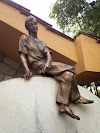Every time I come to Argentina I take a day to visit and pray at the basilica of Our Lady of Luján, which is about 70 km from my hometown (Buenos Aires).
Arriving at the basilica and while asking the priest when I could celebrate Mass, I shared with him I was born on her feast day. By the end of the Mass he was waiting for me with an A4 image of her face. It was a beautiful gift that soon will be traveling to Swaziland.
Looking for the history of Our Lady of Luján in English I found the one below at this webpage: http://en.mariedenazareth.com/
In 1630, a Portuguese resident in the State of Rio de la Plata, owner of a huge territory in the country (Sumanpa Santiago del Estero) 1200 km from Buenos Aires, wanted to build a chapel to the Holy Mother of God on his domain to re-awaken the faith of the surrounding population. He asked one of his countrymen who lived in Sao Paolo, Brazil, to send him a little statue of Our Lady. His friend, not knowing how the farmer wanted the statue to look like, sent two of them: one of the Madonna and Child, the other as the Immaculate Conception. The statues were first shipped by sea, and then placed in the convoy of carts transporting the goods brought on the same long journey.
After spending the night on the banks of the River Lujan, the convoy was unable to start again in the morning because the oxen whose cart was transporting the two statues refused to move. The drivers insisted and tugged all together to no avail! Seeing that the occurrence was unusual, they decided to lighten the cargo by removing the two small statues. When the statue of the Madonna and Child was taken out, the oxen remained planted there. When the statue of the Immaculate Conception was removed, they moved forward.
Our Lady of Consolation
It was decided that the statue of the Immaculate Conception would remain there since the Virgin obviously wanted to make that place her home. The statue of the Madonna and Child continued her 1,150 km journey to Sumampa. It is still venerated there under the name of Our Lady of Consolation.
(If you want to read more, please click HERE)




